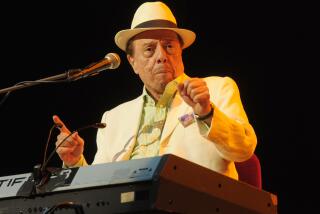Audio shackles stifle the rhythmic freedom
- Share via
The combination of Brazilian singer Paula Morelenbaum with songs featuring the lyrics of Vinicius de Moraes, often described as the “poet of bossa nova,” would seem to be a musical slam dunk. But as recent political situations have revealed, slam dunks sometimes clank off the rim.
On Saturday night at the Getty Center’s Harold W. Williams Auditorium, Morelenbaum’s tribute to De Moraes -- largely drawn from her 2004 CD, “Berimbaum” -- displayed the extraordinary promise and the diminishing misdirection of the project. Described as a “modern, electro-acoustic framework” (whatever that means), it positioned the De Moraes songs, mostly written with music by Baden Powell and Antonio Carlos Jobim, in a fairly typical contemporary remix environment of electronic sweeps and beeps, spoken-word backgrounds and murky synth sounds.
Fortunately, De Moreas’ poetic lyrics, superbly intertwined with Powell and Jobim’s gorgeous blends of melody and harmony, survived the atmospheric distractions. As did, for the most part, Morelenbaum’s singing, with its crystalline sound and irresistible sense of bossa nova swing. But each of those appealing qualities was undercut by the use of recorded tracks with the atmospherics, which tended to limit the rhythmic freedom of Morelenbaum’s fine Brazilian ensemble -- guitarist Fernando Caneca, keyboardist Dudu Trentin and percussionist Alex Fonseca.
As a result, Morelenbaum’s renderings of songs such as the Chopin-inspired De Moraes-Jobim classic, “Insensatez,” and the soaring melody of “Desalento” (by De Moraes and Chico Buarque) were diminished by the distractions of the musical surroundings. Nor did it help that Morelenbaum said virtually nothing about the songs, never offering translations of even the titles for the non-Portuguese-speaking members of the audience.
Ironically, it wasn’t until she came out for her encore, and switched off the recorded tracks, that Morelenbaum’s imaginative sensitivity finally had the opportunity to blossom. With the supportive accompaniment of her musicians -- free now to play at their own rhythmic pace -- she sang an emotionally engaging version of “The Man I Love,” followed by a buoyant rendering of Jobim’s “Ella e Carioca,” revealing the rich, interpretive lyricism that is essential to her art.
More to Read
The biggest entertainment stories
Get our big stories about Hollywood, film, television, music, arts, culture and more right in your inbox as soon as they publish.
You may occasionally receive promotional content from the Los Angeles Times.









